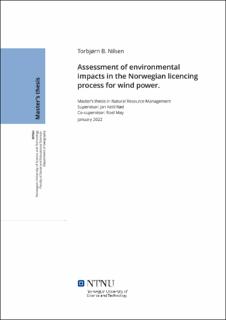| dc.contributor.advisor | Rød, Jan Ketil | |
| dc.contributor.advisor | May, Roel | |
| dc.contributor.author | Nilsen, Torbjørn B. | |
| dc.date.accessioned | 2022-04-28T17:19:44Z | |
| dc.date.available | 2022-04-28T17:19:44Z | |
| dc.date.issued | 2022 | |
| dc.identifier | no.ntnu:inspera:95429081:46776806 | |
| dc.identifier.uri | https://hdl.handle.net/11250/2993299 | |
| dc.description.abstract | Utbygging av vindkraft krever nøye vurderinger av ulike politiske mål, miljøpåvirkninger og andre interesser. Disse hensynene ivaretas gjennom en konsesjonsprosess, som en potensiell utbygger må gjennomgå for å kunne bygge og drifte et vindkraftanlegg i Norge. En slik konsesjon søkes ved å sende inn en søknad til Norges vassdrags- og energidirektorat (NVE), som vurderer søknaden og avgjør om konsesjon gis eller ikke. En stor del av disse konsesjonssøknadene er konsekvensutredninger for miljø og samfunn (EIA), som har til formål å vurdere og rapportere hvordan de omkringliggende miljø- og samfunnsverdiene påvirkes av den foreslåtte utbyggingen. I litteraturen er det imidlertid svært lite kjent om hvordan disse rapporterte miljøkonsekvensene faktisk påvirker konsesjonsbeslutningene for vindkraft.
Gjennom en omfattende datainnsamling fra alle konsesjonssøknader for vindkraft i Norge imellom 2000 – 2020, har denne studien hatt som mål å analysere hvordan disse miljøkonsekvensene påvirket om et vindkraftverk fikk konsesjon eller ikke. Fokuset var på innvirkningen av høye negative konsekvenser for de ulike temaene, hvordan de ulike temaene rapportert i konsekvensutredningene veies opp mot hverandre og om høye konsekvenser for et enkelt tema var nok til å forutsi utfallet av konsesjonsprosessen. Funnene tyder på at høye rapporterte konsekvenser for både kulturarv og naturtemaer vil redusere en utbyggers sjanser for å få konsesjon. Resultatene for de andre undersøkte temaene var mer usikre, noe som indikerer at det fortsatt er uklart hvordan høye negative konsekvenser på et flertall av de rapporterte temaene påvirker det endelige utfallet av konsesjonsprosessen. Det er videre funnet at EIA-ene ikke veies likt, og at høy negativ konsekvens på et enkelt EIA-tema ikke er nok til å forutsi utfallet av konsesjonsprosessen. | |
| dc.description.abstract | The development of wind power requires careful consideration of different political goals, environmental impacts, and stakeholder interests. These considerations are taken into account through a procedure called “the licencing process”, which a developer undergo in order to build and operate a wind power facility in Norway. This licence is applied for by sending an application to the Norwegian Water Resource and Energy Directorate (NVE), who reviews the application and decides if a licence is issued or not. A large part of these licencing application is the Environmental Impact Assessments (EIA), which purpose it is to assess and report how the surrounding environmental values are impacted by the proposed development. However, in the literature, very little is known about how these environmental impacts actually affect the wind power licence decisions.
Through an extensive data collection from all wind power project applications in Norway from 2000 – 2020, this study aimed to statistically analyse how these impacts influence the final outcome of the licence process. Focusing on the influences of reported high negative impacts, how the different EIAs are weighed and if high impacts to a single theme is enough to predict the outcome. The findings suggest that high reported impacts to both cultural heritage and natural themes will reduce a developer’s chances of being granted a licence for the project. The results for the other investigated themes were less conclusive, indicating that it is still uncertain how high negative impacts to a majority of the reported themes influences the final licence outcome. It is further found that the EIAs are not weighed equally, and that high negative impact to a single EIA theme is not enough to predict the outcome of the licencing process. | |
| dc.language | eng | |
| dc.publisher | NTNU | |
| dc.title | Assessment of environmental impacts in the Norwegian licencing process for wind power. | |
| dc.type | Master thesis | |
